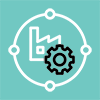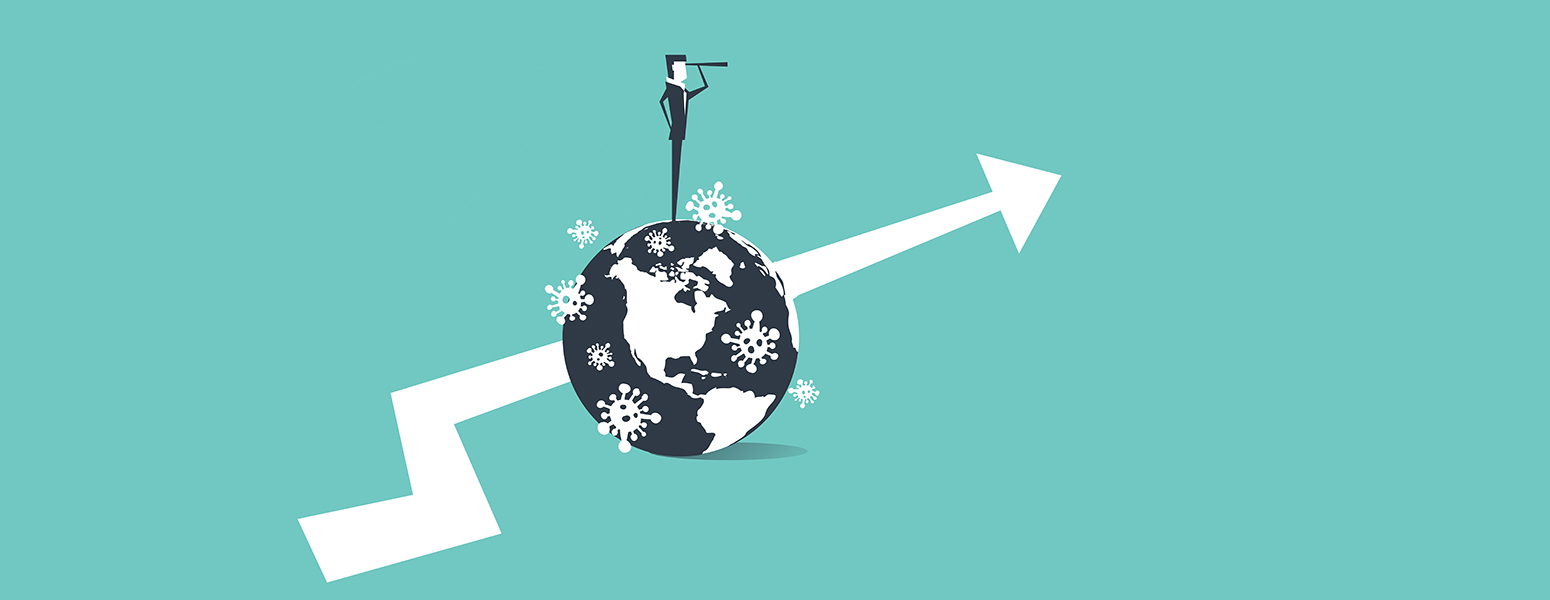Leadership Preparing for a Post-COVID World
It is the middle of 2020 and the World Health Organization reports over 33 million people have been infected with COVID-19, with the loss of life approaching 1,000,000 people. The worldwide graphic models of infections, employment rates, market trends and economic output look like a series of Rorschach tests and given COVID-19’s impact on our physical, economic, geopolitical and psychological health, the metaphor may be apt.
Global consulting firm McKinsey has fashioned terms to deal with the ever-evolving status of organizational life during the COVID pandemic; terms like reimagine, reinvent and most recently, reset. Implied throughout this guidance is that economies, organizations, leaders and ordinary people are in uncharted territory. Organizations have adapted to survive; they have changed. And going forward they will need to rely on lessons learned, and perhaps a changed profile in leadership to move successfully into whatever comes next.
The first question is, in the arc of the pandemic where exactly are we? Richard Sterling is Managing Partner, AltoPartners, Australia. “I’d like to challenge the whole business of coming out of this and ‘the new normal.’ I don’t think we are coming out of the pandemic as yet, I think we’re right in the thick of it. To say that there is a ‘new normal’ is premature.”
Reflecting on past crises, Simon Wan, Chief Executive for Cornerstone International Group in Shanghai says, “In the last six months the world has changed. In 2002, it was SARs, but that was a more limited pandemic, and then the 2008, 2009 global financial crisis. This one is really the big unknown.”
FIRST MOVES
Coronavirus moved like a storm across the world and as countries and economies started to feel the initial impact and understand the implications, businesses made their first defensive moves.
Krista Walochik is Founding Partner of Talengo, Spain. “When the world turned upside down—and those are different dates depending on where the penny dropped—all of a sudden this nano- killer is here and it’s invisible and is just wiping our world out as we know it. And at that point, it was sending us into forced confinement and the first thing that companies did logically was grab cashflow and liquidity. There was a big drive to halt any unnecessary expenses to make sure that they had access to cash. Those who could took additional financing or even loans. So, the first thing was, grab the cash and simultaneously make sure that people were safe, as best as they could, and protect business continuity, which meant sending people home.”
Walochik describes “a huge rush getting people onto safe access lines, having computers, having information. There’s a bank that we talked to that had gone from five percent working from home to 75% working from home in five days.”
Angela Westdorf is Managing Partner for Signium Germany. She describes clients’ similar first response to COVID being “very much focused on stabilizing the company and avoiding everything that’s not absolutely necessary to run the business. Consider the healthcare industry, where elective surgeries were postponed.”
“Focus on the basics,” she observed, “and keep our employees informed.”
For Wan’s clients in the industrial sector, “the game plan was to set up a kind of war room. The CEO and the chief officers meet on a very regular basis to monitor the supply chain, attend to customer care, and at the same time track whether COVID-19 has any effect on the workers.”
Virtually every organization had to react quickly, but companies that had invested in digital had a distinct advantage.
Stefan Spang is a Senior Partner at McKinsey & Company, based in Dusseldorf. “If companies were fortunate enough that they had digitized operations, then many of them would simply have gone into a remote operating mode. Take financial services, banks, insurance companies, everything that is foundationally built upon data processing has quite easily been able to shift into remote mode.”
“Others, of course, where you had a more physical value chain, a manufacturer producing goods, for example, they obviously had to follow a very different approach. Some of them have tried from the very beginning to establish protective measures that allow them to maintain a minimum level of production. Maybe they introduced different shift models, they took particular care that shifts were physically separated, they changed the layout of their operations to allow for the appropriate distancing. All of that under the assumption that they were able to maintain their supply chain,” Spang says.
As teams scattered, processes were disrupted, and the environment was constantly changing, the best- led organizations provided timely, consistent, transparent communication. Renato Bagnolesi is Managing Partner at FESA Group in Sao Paulo, Brazil. “We believe the need to increase the level of communication is very intense. You need to communicate more and more every day for all levels of your company. People—employees and the market— don’t like surprises and increasing communication is one way to avoid this.”
“Good communication brings people close in the organization; communication regarding the business strategy or what our company is doing in terms of the crisis. We have a kind of mini board, a war room, and every week we share our metrics, our P&L, showing the situation. Transparency is increasingly important,” he says.
Jennifer Borrer, Founder and Managing Partner at Borrer Executive Search says, “We work across a wide industry set, and when their communities are suffering, it affects them. But we are seeing many groups stepping up. They’re showing empathy, they’re showing solidarity for their customers and for their employees and suppliers.”
What can you learn out of this crisis? How can you shape your services? This is pretty much something that every single industry or every single client has to think about.
Borrer describes a client’s important COVID-related project. “I had to launch the ‘Are you okay?’ care campaign for all of their employees who were working from home.” Speaking of a trend among her clients, Borrer says, “Even though you can’t meet face to face, they’ve stepped up and been more vocal than ever. It’s strengthened relationships and it’s strengthened collaboration.” She adds, “The AESC State of the Profession report itself said clients are looking to strengthen those two things in their companies, collaboration and relationships. And I think the response we’ve seen has certainly done that.”
Communication helps, but uncertainty remains. Mickey Matthews, International Chair at Stanton Chase shares a common concern. “I was on a North American Regional call yesterday and we were saying, is the rebound going to be economic, are we going to reopen, but then will we have to go back to stay home again? In the US there are still a lot of cases and deaths are still very high, but cities and states continue opening. The big concern is, will we open up and then close back down again?”
These first moves by organizations under pressure may also turn out to be somewhat of a values test. Walochik explains, “During the lockdown period, we reached out and talked to lots of executives, CEOs, board members and asked them how they were dealing with the pandemic. I was fascinated that one of the earliest conversations with board directors was about executive remuneration, dividends and their own remuneration, and they were concerned about it. ‘All of this is happening, so how are we going to pay our bonuses? Do we pay our bonuses to our top management team? If we can’t pay them, how are we going to hold on to people? If we’re looking at furloughing people, what do we ask of our top management teams? What have we asked of ourselves as board members?’ It was fascinating to see virtues in action depending on the decisions they were making.”
“I know of an insurance company that furloughed 80% of their staff and continued paying out a significant dividend. I know another company where the board members took cuts in their income for the lockdown period,” Walochik says. “What different companies did at that time is going to mark who they are going forward, and how they’re seen.”
As organizations endeavor to get back to “normal,” it’s important that their leaders, indeed all leaders, reflect. Morten Nielsen is Senior Partner and Global Managing Partner for the Life Sciences practice at WittKieffer and serves as AESC Board Chair. “If we just go back to our caves and do it like we did before, then I think this has all been for nothing. But if we can learn from this, we can all get ahead.”

LESSONS LEARNED
The catalogue on lessons learned from how organizations, governments, and communities operated through the pandemic may be updated for a long time. However, even the early learnings are many and meaningful.
 1. BE PREPARED
1. BE PREPARED
COVID-19 caught much of the world unawares. Nielsen shares, “In the back of everyone’s minds it was always, ‘this is a paper exercise, it’s not going to happen.’ I think now people are going to go into disaster preparedness with a whole different level of seriousness.”
Now that we're in it, Ullrich Ackermann, Chair of the Board at TRANSEARCH, says “It’s important to take lessons out of this rather quickly. So, what can you learn out of this crisis? What can you do? How can you shape your solution? How can you shape your services? How can you shape the sale of your product? This is pretty much something that every single industry or every single client has to think about.”
More likely than not, the next generation of disaster preparedness plans will be predicated on having completed digital transformation.
 2. GO DIGITAL
2. GO DIGITAL
“All the IT companies, et cetera, are the winners of the COVID situation,” Ackermann says. “Companies that have already invested highly in digitalization over the last two, three years are probably better off than the ones that have rather neglected or postponed it.”
What kind of difference did it make? Wan considers employees who found themselves on the outside when China locked down. “They are not able to return to China. You still try to make sure that they can contribute, even though they are stuck in Singapore or Hong Kong or in New York, because they cannot come back. The technology like Zoom, WebEx and the others, even many local video conferencing tools are very good. For many companies that were not very active in the digital or e-commerce sector, they are now really trying to get help and have a new strategy to open up that side of the business.”
Bagnolesi observes, “As a result of COVID, things are changing,” he says. “Not for belief, not for love, but unfortunately—for certain organizations—for pain.” Despite the pandemic, Brazilian organizations have been trying to survive since 2013, after recurring economic and political crises. New investments, especially in new technologies, are more complex.
Consider contract management, document signing and logistics management through tech, e-commerce, payment systems and companies using AI to engage with customers as the first point of contact. Sterling says, “Technology has taken on such a central role in business, and any company that’s been reticent about making the digital transformation or spending more money on updating and securing its technology is probably wishing that it had done so.”
For those tech-current organizations, we’ve also learned that yes, people can work from home.
 3. REMOTE WORK WORKS!
3. REMOTE WORK WORKS!
Sterling says, “Working from home has proven to be an amazing thing. People actually will work from home and will do an honest day’s work for you. And that’s a testament to the culture and the leadership pre-COVID, to some extent. Mostly, people have a genuine desire to deliver and do good things.”
Bagnolesi recalls one client’s reaction to his firm’s home office policy. “In January of 2020, a client, the HR leader of a very conservative company here in Brazil told me, ‘Oh, you’re implementing home office? The leaders, the directors, they disagree.’ This client started a home office pilot in one small area of the company, with reviews planned through the months to check, recheck, and double check if it was working. And then because of the pandemic, in two weeks the whole company is working from a home office!” He adds, “And it’s working. This is the kind of situation that companies are facing: a very conservative mindset and they are changing everything not because of belief, because of the pandemic.”
 4. CASH IS (STILL) KING
4. CASH IS (STILL) KING
A major disruption that interrupts business operations or depresses customer demand, or in the case of COVID, both, can have a disastrous impact on cash flow. Part of being prepared is liquidity. Ackermann explains, “Especially in Germany, many companies, especially the midsized family-owned businesses, have learned from the financial crisis that the banks that give you an umbrella when the sun shines want the umbrella back when it starts to rain. People have taken learnings out of that and have raised their own share of capital in order to be liquid in such difficult situations.”
Companies that are liquid can meet payroll and other obligations and can purchase components or supplies to resume business when the crisis abates. Companies that can’t may not be in business when that time comes.
 5. BE AGILE
5. BE AGILE
“One of the learnings that in my mind, one of the big outcomes specifically for healthcare and life sciences is that there’s always been this rhythm of, we have to do these things sequentially,” Nielsen observes. “We have to complete part A and analyze before we start part B. Now all of a sudden it turns out that we can actually do a lot of this, if not totally in parallel then at least not totally sequential. And in this situation, we need to take chances that we thought were unthinkable six months ago. All of a sudden they’re not just necessary, they actually help us get to the endpoint sooner, and still under the same safeguard we had prior to this.”
Westdorf describes the value of agility in Germany’s vital Mittelstand sector. “Those companies that have been able to develop new, agile, digital business models fastest are the ones that survive. There are quite a number of family-owned businesses that are traditional, with senior people running them. In some cases, they have not been up to date concerning digitalization and have not been able to speed up fast enough during this time. Therefore, it’s really important that they realize their competitive edge is no longer necessarily based on something they’ve done traditionally.”
For Matthews, some of the learnings and some of the takeaways are “the acceleration of trends and the speed that’s required in today’s business. I’ll give you an example,” he says. “Different people have different rules of thumb. My rule of thumb was that if I had 80 to 85% of the data, then I’d make a decision. Now you need to make a decision on 60 to 65%. So, the speed in decision making has picked up and then the speed and agility of mid-course correction if necessary must also.”
 6. SUPPLY CHAINS ARE FRAGILE
6. SUPPLY CHAINS ARE FRAGILE
Borrer leads the supply chain practice at her firm and sees first-hand the vulnerability of global supply chains. “What we’ve seen is the pandemic has really revealed the weakness of the globalized supply chain network. This has been very challenging for all companies, whether they were affected negatively or positively.”
Westdorf provides a chilling example of what can go wrong. “In the pharmaceutical industry, if the API, the basic ingredients for pharmaceutical products can’t be delivered from India, all the pharma companies have got a very, very serious issue—they can’t produce anymore. So, the supply chain, I think, might become more regional and an adequate risk management will be much more important in contrast to the past. And people, consumers, as well as patients and health insurers, will have to be prepared to pay more not only for services, but also for products, for medicine.”
 7. KNOW WHO’S NEXT
7. KNOW WHO’S NEXT
The failure to plan for executives leaving their companies, not being up to the task of the COVID crisis, or worst of all falling ill, left many organizations with a painful lesson on the importance of succession planning.
From Walochik’s perspective, “Most of the boards and top management realized that they did not have a contingency plan for leadership. They had succession plans that HR had put together that sat in somebody’s drawer, but the succession plans are looking typically two, three years out. And what they realized was, wow, we were lucky we made it through this one, but we did not have a contingency plan for our key top people.”
 8. COLLABORATE
8. COLLABORATE
“One of the things I hope that we’re going to learn from this is that even when you might consider some other institution or some other company a competitor, the reality is that in many cases, the competition is maybe 10, 15% of what you do, and you don’t see the 85, 90% where you can actually have complementary skills and capabilities,” Nielsen says. “I hope we’re not going to unlearn what we just learned.”
This situation also has created psychological challenges for many people. And being there for your people and offering help whenever needed, I think that has made a big difference.
Spang sees leaders learning to “reach out a lot more extensively, also beyond the boundaries of their own organization.” One of the benefits of restricted travel, he finds, is that people are available. “We have organized a whole lot of events, not very formal ones, just discussions, roundtables you would have called them in a physical setting. People got together for an hour on a video conference from across many different organizations to share perspectives on a common theme. When you normally try to do that in the physical world, you would have had to send out invites months before and would have had response rates of 10% on a good day, and who then actually showed up was a whole different matter. This now goes from one day to the next almost without any problem and with totally different response rates. People are a lot more willing to be flexible in their diaries, to make the extra time. You can get CEOs with a few days’ notice to come onto an hour’s video conference to have a discussion.”
 9. INNOVATE
9. INNOVATE
For Wan, “The key learning is the importance of innovation.” For example, he says in the last four or five months, Cornerstone’s 20 or so consultants have used the digital media platform TikTok to create videos for clients. “We’ve been able to produce about 400 videos that we put in a training archive for coaching projects. At this time of lower capacity, we asked ourselves what is our strength, and what does the client need? So, we tried to break down some important leadership concepts into short TikTok videos.” Wan laughs, “It’s a good idea; if you cannot explain in one minute, there is something wrong!”
“Clients love it because we basically have a whole syllabus of coaching subjects. Each of their staff can log in on their own time, and at the same time, we have regular scheduled webinars that they can join. So, we are providing different things on different technologies,” Wan says. “It is also fun.”
To help clients manage through the pandemic and the next big disruption, Bagnolesi’s firm is also developing new products. A timely offering, he says, is “a product called Boot Camp. It is coaching for crisis management.”
 10. BEND NOT BREAK
10. BEND NOT BREAK
A key COVID-era lesson is flexibility. Spang says, “We will be seeing much more flexible modes of collaboration across different parts of the organization, but also with partners and equally between suppliers and customers and the organization itself. We will intensify the use of technology even more, and a lot more seamlessly. We will therefore discover quite a few more reserves in terms of productivity and efficiency. And this could really bring us to the next S curve of what we might have imagined the way of working to be 10 years from now.”
Matthews sees the lessons of flexibility in how organizations envision how and where they work. “Expatriate assignments were getting smaller because companies weren’t investing in those and people just didn’t want to relocate, weren’t as flexible—dual incomes, things like that. Out of COVID, we’re seeing an acceleration and an increase in that trend where candidates don’t want to relocate away from family because all of this has changed people’s mindsets. So, there is again an acceleration of that trend on lack of mobility of candidates and employees. The changes in companies that are ahead in terms of best practices, our clients, they’re moving the jobs to the people now. They’re not moving the people to the jobs because people will not move. So, clients are becoming more flexible. This again is the futurist view, where companies are more remote, more virtual.”
Practical flexibility is also important. Bagnolesi says, “I am recruiting a CEO for a new fintech company here in Brazil, and I called my client two weeks ago with a new candidate. The client said ‘okay, good. Could you open your office for a face to face interview? And I asked, sorry, my office? Yes. Your office! A face to face interview. Ask the candidate if it is okay. So, I called my partner who lives two blocks from the office—'he said what?’ So, with mask, everything, we opened the office and the client went in to interview this C-level candidate face to face.”
What different companies did at that time is going to mark who they are going forward, and how they’re seen.
 11. MENTAL HEALTH IS HEALTH
11. MENTAL HEALTH IS HEALTH
For several months now, executive leadership has been under the extraordinary stress of tremendous uncertainty and accountability. “Management teams are exhausted,” Walochik says. “They’re just totally wiped out because of the hours, because of the stress, because of the uncertainty, because of maintaining their own teams, because of working from home with the dogs, with the kids, with the spouse, or working alone. And in our case in Spain, with 45,000 deaths, they’re also dealing with losing parents, losing in-laws, losing close friends. It’s been an incredibly, incredibly difficult time. What we realized is that companies were not really recognizing the emotional stress that managers were going through. And that has a concrete effect on your cognitive skills, the way your brain works. That’s going to be a huge issue over the next several months, because the pressure that everyone’s going through and the anxiety, the uncertainty, et cetera, is not going away.”
Spang agrees, “We should not forget that this situation also has created psychological challenges for many people. To be locked into a place for an extended period of time, not to be able to go out much. And again, it has been very different in different places, different countries, but there have been situations where this has been really depressing and has had quite negative effects. And being there for your people and offering help whenever needed, I think that has made a big difference.”
 12. BE HUMBLE
12. BE HUMBLE
“You have to make sure that there is going to be life after the corona crisis,” Ackermann says. “That the company will survive, that you are trying to maintain as many jobs as possible. You cannot give guarantees, but you have to make the people understand that they are important, that you count on them. And on the other hand, you have to be humble and make the people understand that you don’t have all the answers. Nobody has, but you are willing to learn. You are willing to adapt, willing to listen. And I think that’s what has changed.”
For Walochik, “There’s another piece of this, around how vulnerable we actually are, how vulnerable we are in terms of our reliance on supply chains, how vulnerable we are in terms of reliance on ongoing business, how vulnerable we are in terms of our leadership team and capability. It has been a very humbling experience for those who are willing to look really straight on. I think there’s a piece around humility and understanding that we’re much more vulnerable than we thought we were.”
THE WAY WE WORK
The pandemic has indeed been humbling, and it dramatically changed the way we work. There is no universal agreement on what the long-term impact of COVID will be, or whether these changes will remain if there is an “after” COVID.
“Clients are asking, ‘What does a business look like as we climb out of this?’” Nielsen says. “Not that we’re out of it by any stretch of the imagination.”
For Nielsen, “The word ‘recovery’ to me has an indication that we think we’re going to go back to where we were, and I don’t think that is going to happen. We are going to get back to living a different way than we do right now, fortunately, but it’s not going to be what it was before. It’s not going to be better it’s not going to be worse, but it’s going to be very different.”
THERE IS NO RETREATING FROM TECH.
“It would have been very interesting to imagine what this entire crisis would have looked like 15 years ago when we didn’t even have our smart phones,” Spang says. “The IT infrastructure was in a totally different place. There was no streaming, there were no smart phones. We would have had to dial up into some host computer, and it would have been a totally different place. There would not have been any thought of remote schooling and education. So, the bit of luck that we had in all of this is the power and robustness of the technology infrastructure that we have put in place over the last 10 years.”
Sterling observes, “If nothing else about this COVID lockdown experience, we’ve learned that technology has really played a prominent role not only in business, but in our personal lives. From a business perspective, highly secure remote desktops have become very important. Systems such as those that provide digital security, manage contracts, facilitate B2B, B2C transactions, identity verification, collaboration are really rising to the fore in how we are doing things.”
Cloud services make the sharing of work products seamless and staying connected while working remotely is simplified by tools like Zoom for video conferencing, and WeChat, Slack, Microsoft teams, and WhatsApp for communication and collaboration.
REMOTE WORK IS HERE TO STAY.
Digital tools and remote desktops have further enabled remote work for professional employees worldwide. Sterling says, “It is interesting when, instead of work coming home, home becomes work.”
A study conducted by Condeco Software largely before the COVID-19 outbreak found that of the nearly 1000 businesses from seven countries surveyed, “nearly two-thirds of them expect more remote working in the next year. That figure rises to 70 percent if you extend the horizon to three years. But before we herald a new dawn, remember that one in ten companies are still not offering either flexi-time or remote working to their employees.” (The Modern Workplace 2020 Report. Condeco Software)
The pandemic clearly accelerated that trend, and there are benefits and there are risks. For example, from the talent perspective, accepting an offer may have once required relocation. Sterling says, “Well, you probably won’t have to anymore. If you have an accompanying spouse with a career, if you have children who are in a good school, you don’t have to disrupt them. The number of times I have interviewed senior leaders who said, ‘I really want this job, but I have to say no,’ because they had to relocate—now they can say yes because companies are beginning to accept that COVID means talent doesn’t have to be in same building, city or country.”
Clients were looking for top talents with the ability to deal with ambiguity and the ability to drive change. COVID has accelerated the need to deal with ambiguity, and to move with speed.
On the risk side, Sterling asks, “For employers, how do you maintain a culture? What will that culture look like now that some will work from home and some will work from the office? And what about privacy? Are we seeing too much in the background when we’re on a video meeting? CIOs are asking, ‘with so many working from home using their own computers and connections how do I guarantee that customer data is protected? How do we protect our IP?’ CIOs know that hackers are also working from home, and they’re working overtime.”
WE’RE STAYING CLOSE (FROM A DISTANCE)
Keeping a safe physical distance from people to prevent the spread of COVID is having a profound and perhaps lasting impact on how people in business stay connected: to peers, to customers and clients, and to employees.
The economic impact on the travel industry is massive, and as organizations become accustomed to remote meetings, business travel may not fully recover. Spang says, “I do not believe people will be traveling six, seven hours to have one or two-hour meetings. That part will happen via video or via telephone. People will be much more deliberate about when they make a trip.”
Without face-to-face interaction, how do we maintain relationships with clients, customers, suppliers and investors? For Bagnolesi it comes down to communication. “In communication with clients, you need to keep them close and be understanding, ‘What’s going on, what’s the situation, what’s the problem.’ Ask about the business problems, how clients are managing in the pandemic.” Bagnolesi advises being available to them. “But it is not selling something, it is being more understanding of your client’s situation.”
What about new relationships? Bagnolesi says, “It’s very hard to attract new clients during this situation. It’s a trusted relationship, and it’s very hard to develop a new relationship with a cold call.”
Westdorf agrees that it’s very hard, but sees that today it is possible. “Keeping in touch with your clients is fine; talk to them regularly, have briefings concerning your assignments via video conferencing, that’s fine. But really getting new clients, really convincing clients and developing trust? I felt that was impossible virtually, and I’ve been proven wrong on this one. It is possible, mainly due to the fact that it’s not been out of my personal will that I’m not coming to visit them, but it was just impossible. So, we had several video conferences, we really talked extensively, and I was positively surprised that yes, it is possible to develop a relationship. I still think it’s a huge difference in contrast to meeting in person, but it’s a base, it’s something to start off with.”
WHAT ABOUT CULTURE? WHAT ABOUT RELATIONSHIPS WITHIN AN ORGANIZATION?
“There’s going to be an impact on the people side of business and on the culture of companies,” Matthews says. “There’s going to be a need to reengage employees. There’s going to be the need for a re- recruitment of employees.”
Distance can change how people feel about their organizations. Matthews explains, “I’ve seen some studies that as people come back in China, absenteeism at the plant is a lot higher than it was before. Absenteeism used to be 7 or 8%. It’s now at 20%. So, we all need to look at that and say, is that going to happen to us? We need to reengage, we need to rework, re-recruit. Culture is always difficult to maintain. Culture always takes a lot of hard work, but if we’re going to be more remote, more virtual, it’s going to take that much more communication and really that much more identification with the purpose of the company.”
Ackermann agrees that due to remote work, “The relationship has changed and is changing over time.” He advises, “You have to trust your staff that they are not going to the beach, but they are working in a serious way. You have to look for the output and not for the input, and giving more trust as well to your employees, that they don’t betray you. It’s a situation where the level of trust is certainly more requested than ever before.”
Nielsen says, “There might be some really smart industrial psychologists that can come up with other ways we can do this, but I do think it is going to be a challenge. We all have these different spheres in our lives that give us a sense of belonging. For most of us, the belonging related to our work is pretty important, and if that gets diminished, I think it has a lot of impact on how solid cultures are. It has an impact on retention of leadership.” Nielsen adds, “In a scenario where that sense of belonging, that sense of team has been diminished, it is going to be even more difficult to get a team to glue together and work through another Black Swan event.” He warns, “Because there will be another.”
We work across a wide industry set, and when their communities are suffering, it affects them. But we are seeing many groups stepping up.
UNANSWERED QUESTIONS.
“No one can tell whether the pandemic will continue like this for another two months, three months, or even 12 months,” Wan says. “So, we have to find new ways to get things done.”
What industries will thrive and which may die, we don’t know. The shape of our workplaces, communities, and even our families continue to be affected in ways we can’t predict. Much of what we’ve already seen defies explanation, and what’s to come defies prediction.
Sterling asks, “What are we doing as an employer for those who can’t work from home for whatever reason? The home may not be big enough to have a discreet space or the internet connectivity’s just not as high quality to support online video conferencing, or what if people just need the interaction of others to be fully productive? How are we supporting them? And then for the employees who are coming to the office, am I supplying them with masks and sanitizers? Am I tapping into resources to help employees who are feeling emotional distress? When you have an office environment, occupational health and safety is obvious, but where does it sit when you have some of the team working from home?”
And the final question Westdorf asks, “Businesses are now in a situation where they have to decide, do we have the right leaders in place? Are these leaders from before the crisis, are these the right ones to carry us in the future? Because we see quite a few of those who were not agile enough, were not willing to take risks, or leaders who were not really dealing in the best, most compassionate way with their people. They will have difficulties in the future.”
And what the future looks like will depend in part on leadership.
PROFILES IN LEADERSHIP
Leaders worldwide in every kind of organization have been tested. It’s too soon to tell how everyone might have scored, but clearly certain traits and skill sets rose to this unprecedented occasion, and those qualities and abilities will be game changers for organizations moving through the pandemic into whatever the future holds.
For Borrer, “Good leadership principles have not changed in good times or in bad. Authentic leaders who continue to lead by example, to show agility and the ability to move people will continue to be sought after. True leaders will emerge from this crisis and people across organizations will be looking to them for direction. Companies will look at who stepped up and who didn’t, who was agile enough to adjust in this new environment and who wasn’t.”
Walochik quotes Warren Buffett. “He says, ‘when the tide goes down, you can see who is wearing a swimming suit and who isn’t.’ What we’re seeing now is one’s true management style, because now there’s no place to run, there’s no place to hide. Everything is results-oriented. Everything is about aligning people. When you can’t reach out and touch them, you have to do things in a different way. It’s being able to stay balanced; keeping your wits about you. Leaders through this crisis are those who are able to deliver horrible news, who recognize what they don’t know, who took steps earlier in the crisis to keep people safe, who are thinking outside the box, and who are good at setting up different teams to deal with the present and others with the future.
For those with a skillset of managing predominantly in a face to face setting—‘if I see you, then I know you’re working and I can follow your tasks and your production, I’m watching you’—the rug was pulled out from underneath them and their management skills just do not work.”
Matthews discusses the evolving demands of forward-looking clients. “One of the traits and attributes that clients were looking for in top talents was the ability to deal with ambiguity and the ability to drive change. COVID has accelerated the need to deal in white space, to deal with ambiguity, and to move with speed. So again, this is that acceleration theme that businesses are seeing and responding to, and again, figuring out how do we adapt and then what’s going to stick as we recover? The other theme that’s come out of it is speed, speed in decision making has had to quicken, has had to hasten. Speed in go to market has picked up.”
“Unfortunately,” Bagnolesi says, “Crisis management is part of the everyday skill set of a leader in Brazil. Who in Brazil has managed a company without crisis? This is part of our day to day. It’s not new. Pandemic, yes, but crisis is not new.” Brazilians may have just the skills for these unique times. He says, “Brazilians are active, creative and resilient; they are very resilient and hard workers.”
Leaders will need to be decisive. “Let’s face it, “Borrer says, “Many companies are still striving to remain solvent. Certainly, empathy and compassion are important, but keeping businesses alive is equally important. And we will need leaders in place that can make these tough decisions, that excel in truly leading and inspiring their people, often remote teams, and that are consciously addressing the social and environmental crises that are happening alongside the public health crisis. We’re seeing companies step up and say, we value diversity, inclusion, we value information sharing to drive engagement. Future-proof leaders will show all these qualities.”
She adds, “In January, we were at the peak, the top of an economic cycle. By March, we’re at rock bottom. This has been volatile change one day to the next and leaders that have been very agile, able to step up and mobilize people, those are the types of skills that we’re going to be looking for in future-proof leaders.”
From Westdorf’s perspective, “It’s the combination of being highly innovative, being caring and compassionate, with a stronger focus on agility, on being able to change an organization or a process within a very, very short period of time. Companies develop new products parallel to their existing business all the time, but it was never that their existing business was absolutely under pressure. These days, you have to be prepared for a shutdown and you might have to change from day one to day two, and that’s the new quality. It’s new for all of us and it is separating good leaders from the ones who have not yet learned to maneuver organizations through a difficult period of time.”
Those companies that have been able to develop new, agile, digital business models fastest are the ones that survive.
So far, at least, “What we’ve seen through this is that the successful leaders are authentic, and so this will need to continue.,” Matthews says. “They’re authentic, they’re transparent, they’re direct. And by that I mean, if they don’t have the answers, they say that. No one has the playbook on this.”
THE PROFESSION AND THE PANDEMIC
The profession is experiencing some of the same market effects as other businesses, as client organizations reduce spending and try to figure out the way forward. As well, the pandemic has affected how the search and advisory services conducts business and innovates for the future.
Wan sees, “Many searches are either canceled or have been put on hold. Some of the candidates that were supposed to be on board in March, April or May have been asked to delay. Especially in different countries, let’s say in Singapore, Malaysia, and even China, even though you have a work visa, you’re not allowed to come in for the last two, three months. We see the new start of executive search assignments are slower than last year and only for the so called ‘very critical hire’ are we being asked to continue on, which is reasonable because the CEO’s key objective is to try to maintain the operation, keep it level.”
The need for top talent has not changed, according to Borrer. “There was a talent deficit before COVID and there’s a talent deficit right now. Putting the right leaders in the right roles is what our profession is here to help with, and I don’t think that will change, I think it’s just the timing. We are seeing companies holding back. I think certainly justifying a big expensive spend is hard right now, so I’d say 80% of our clients have to some degree placed a hiring freeze. They just want to wait and see. Also, it’s not the right time to let go of those leaders who are not stepping up to the mark because they’re still somewhat in firefighting mode. We just need to get through this period before we look at the leaders who stepped up, who didn’t, who do we keep and who do we not keep? I don’t think we’ll be seeing that until the end of this year. And when that happens, we have a role to play.”
For example, “Companies are at the moment analyzing their organizations,” Westdorf says. “So, leadership consulting is at the moment returning to business by having to assess whether those leaders are the right fit for the future. On the other hand, executive search becomes very important again when it comes to finding critical leaders. We always knew the stakes were high, but COVID has just proved with a lot of force that the right people will make or break a company in crisis.”
Ackermann explains the way he gauges how the business is likely to fare. “If I look at executive search, we have a rule of thumb, which is roughly 60% to two thirds of our searches are always replacements. This will be shrinking a little bit, but not that much. What will shrink or go away more or less completely is the other third, which is newly created positions for expansion, for new businesses or going into new markets et cetera. This will certainly shrink tremendously. And that’s why I would assume that search business would fall to 60% of what we had in 2019.”
To put the COVID crisis in context, Ackermann explains, “After the 9/11 crisis, business dropped by roughly 35% over a period of two, three years. And it took us five to six years to get back. The numbers were roughly the same in the global financial crisis, but the difference was that the business did not shrink over three years, it fell off a cliff by 36% from one year to the other and then it climbed slowly back up again. But again, it took us five, six years. I think that we will most likely find a similar scenario here because this pandemic is hitting everybody even stronger, because it really hits 95% of the industries.”
The key learning is the importance of innovation.
Limitations on face-to-face contact has affected how firms conduct their business, both in terms of serving clients and what they have to offer.
Due to lockdowns, travel restrictions, and general safety precautions most searches today are conducted remotely. This can be very difficult for many clients. Wan explains, “Especially for a lot of large family businesses, the owner, or the founder would need to have tea or have a lunch or dinner with new people. They will decide no matter how good you are. So, those decisions are being delayed. For CEO appointments, or even senior executive appointments, the culture fit and the chemistry are much more important. For a proven executive with 15, 20 years’ experience the track record is a given, but the chemistry and the fit with the owner or the founder are important.”
Bagnolesi describes a client who stopped the hiring process mid-offer. “Everything is ready to sign, but the client is waiting. They don’t see how they can introduce a new executive to the team. They can’t onboard someone at the C-level through video conference. We have a lot of conservative clients who are waiting.”
In order to bridge the gap when clients are unable, for whatever reason, to fill a permanent role, “One of the services our profession provides to our clients is interim management. Nielsen says, “The demand for that has actually gone up during the pandemic, rather than down. It is a reflection of the fact that, A, they don’t have the bandwidth to go through a full executive to search, and B, a lot of organizations, as they’re trying to deal with the shorter term issues of cashflow management, of disaster preparedness, of supply chain, et cetera, they’re also thinking what does my organization need to look like at the other end of this?”
Walochik adds, “Retained executive search is probably, right now, one of the most important key advisors to boards and to CEOs to make sure they get the people issue right, get the talent issue right. When they attract, retain, motivate and engage the right talent, then they are a step ahead of these different waves of change.”
SILVER LININGS
The worst of times often brings out the best in people. The COVID era is no different.
Wan sees the impact of the crisis on his clients. “After some months working from home, I feel, that they have become a changed executive.” Wan explains, “The CEOs today are much closer to the staff in their local operation. At the same time, they are having a new lifestyle at home with the family. I think most of them have a stronger family relationship. So, this is great!”
Borrer says, “I had one fantastic client, it’s a French food production company and the head of their production did fall ill and the headquarters team actually went on to the manufacturing sites, the head of HR and these non-technical profiles. And they were all working on the factory floor, on the production line. The whole company, regardless of their role showed up at the factory, rolling up their sleeves and getting stuff done. It was heartwarming, our client saying, ‘We will not let France starve.’”
Nielsen describes “the concept of using antibodies from patients who have recovered from COVID-19 that they use to treat other patients.” He says, “Every patient can really only donate plasma to potentially treat two other patients, so it’s not really a scalable solution. There is, however, the ability to isolate super antibodies, and mass produce them to treat thousands of patients. Two companies and a research institution have put together what looks like a very doable plan to do this. The National Institutes of Health knows how to isolate the plasma, the Australian company CSL is a leader in plasma fractionation, and the Japanese pharmaceutical company Takeda knows how to scale up manufacturing. In less than three months they’ve put together a plan and are working together.”
Working from home has proven to be an amazing thing. People actually will work from home and will do an honest day’s work for you.
Sterling describes the craft beer scene in Australia. “When the brewers had to shut down, a lot of them were saying, well, hang on, we’ve got all these tanks sitting there empty. Why don’t we start making sanitizer? Right across Australia, brewer after brewer started turning their tanks to the production of hospital-grade sanitizer. And many were just giving it to the people on the COVID frontline, doctors, nurses and cleaners in hospitals and clinics. And with the beer that they had stockpiled, they started packing it into four and six packs and distributing it to the frontline people. They were calling it ‘thank you packs.’” “It shows leadership, it shows vision, and it also shows that businesses are not islands. They are parts of communities,” Sterling says.
THE HORIZON
What do we know about what’s next? The realities of the coming months and years may be painful, and the change that is upon us could be transformational.
Wan sees the possibility of a new world order. “Being global has a new meaning, now. I think the world could become China plus one, or USA plus one, or India plus one, or Europe plus one. Basically, having a global supply chain and global market—that concept might be being challenged quite a bit in the next five years. The market would tend to become more regional rather than global. A global market will have a new meaning in the future, and that would affect organizational design. And at the same time, it would affect the talent flow. Somehow the mood of global business has changed. That’s the reality.”
Another reality is that businesses that survive will need to adapt. Borrer says, “We’re going to see companies working very hard to overhaul their infrastructure. Not just going to digital and AI initiatives, people will really play a key role in the recovery model. How companies look at their senior leaders will need to change. They’re going to be looking at how leaders have responded and handled the crisis. Did they prove themselves up to the task? If not, why not? Where have they spotted gaps in talent as we continue to move forward with a high degree of ambiguity post COVID. Hiring the right leaders in the right roles will be more important than ever now.”
There is no escaping that there will be failed enterprises and everything that goes with it. “Like always in a crisis situation, there are losers unfortunately, but there are also winners,” Walochik says. “And then there are folks that are just transforming the way things are done, just totally new services, et cetera, and making life a better place for everybody. I don’t know if it’s a silver lining; they say that after the bubonic plague came the Renaissance.”
Nielsen thinks, “It is going to be really interesting to see how our cultures and behaviors and values have changed as a function of this. Right now, we’re much more focused on how do we get through the next X months, how do we get into the new normal and how is it going to function. But, the next phase, which is much more looking back and trying to understand how does this impact our society? I think it will be really interesting.” However, Nielsen warns, “Going through five years of world war relative to going through 18 months of COVID-19; the shorter the experience, the shorter I think memories will be.”
Spang is on a similar page. “I am not in the camp of people who say everything will be different going forward, ‘Oh, this is the new normal,’” Spang says. “I believe a whole range of old habits will come back very quickly, as soon as the situation allows. I think we are observing thisalreadynowwiththerelaxationsof some of the lockdowns, where people seem to revert quite immediately to some of the old practices.”
That may be good news for Ackermann. “I don’t think that we will have the same situation once we are out of this, because we simply cannot afford it. If we would remain sitting at home without using public transport, without using our cars, without going to our local restaurants, without going to our local clothing store, et cetera, then those people will not survive. And if they don’t open, if you don’t go there and support them, then they will not buy cars, they will not buy clothing, they will not buy anything else.”
He reminds us, “We are facing a situation with no consumption, we are strangling our economy and we are strangling ourselves.”
And Bagnolesi reminds us, “It is a skill to survive, but we need to reinvent ourselves and our businesses to win.”
"The word ‘recovery’ to me has an indication that we think we’re going to go back to where we were, and I don’t think that is going to happen. We are going to get back to living a different way than we do right now, fortunately, but it’s not going to be what it was before. It’s not going to be better it’s not going to be worse, but it’s going to be very different."
- Morten Nielsen, Senior Partner and Global Managing Partner for the Life Sciences, WittKieffer; AESC Board Chair
From Matthews’ perspective, “I am very positive on how we’re coming out of this because I’ve seen just great people step up. If leaders can be comfortable empowering great people and getting out of the way, not only are we going to overcome this, but we’re going to thrive. If you can put people first, empower them and get out of the way, amazing things can happen.”
The crisis put a lot of concepts to the test. For example, Sterling says, “A lot of companies have discovered that strong cultures have allowed them to flourish and to have the success stories that we have heard about, that people will respond to moments of need and crisis, and that people can work from home and be productive and in fact, even improve productivity. And I think that is a testament to having a great culture beforehand.”
However, he says, “Some hard lessons will still need to be learned because we’re not out of this yet. What if a vaccine is never to be discovered? What if one or more of my key talent become infected and worse, die this month? What if a critical part of my supply chain or market is seriously or possibly irreparably disrupted by COVID- fuelled geo-political maneuvering? You’ve got to ask these sorts of questions, and consider how it will impact business, employment, talent aquisition and management, succession planning and all of that as we go forward?"
Wan says, “In a pandemic like this, no one was well prepared. But I think the quality executive is to be able to adapt, find the positive as well as deal with the negative, and at the same time, build a strong company culture while making significant changes. Sometimes it’s quite painful, but we have to be more prepared for the next 12 months, not just the coming month. We have to be more prepared for the next 12 months than we were for the last 12 months.”
Westdorf sees COVID-19 as an accelerator for having a larger focus on sustainability. “Companies, employees and leaders have realized how vulnerable our system is; our whole economic system, and our whole world. So, it’s really much more focused on, how can I make sure that I’m doing the best possible work in the best possible way for not only people, but also for the product, and also of course for my company?”
“There will be good things coming out of this,” Walochik says. “And I am personally betting on a more sensitive, more humanistic, a more long-term way of understanding what our role is to society, to the planet, as well as to our shareholders.”
Spang adds, “Just out of care for all of us, please keep in mind this isn’t over yet.”
Get AESC SmartBrief for the latest in C-level news.





